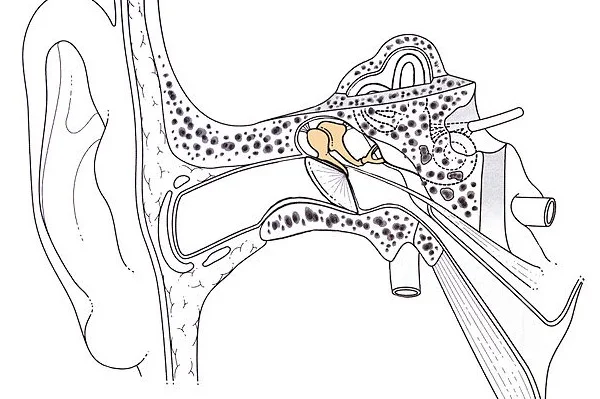
Stapedotomy is a surgical procedure used to treat a condition called otosclerosis, which is the abnormal growth of bone in the middle ear. Otosclerosis can cause the tiny bone called the stapes to become immobilized, which can lead to hearing loss.
Why is the surgery done
After Stapedotomy surgery, there are some things you can expect during the recovery period. Here are some common experiences:
- You may experience some pain, discomfort, or a feeling of fullness in the ear after the surgery.
- You may feel a bit dizzy/vertigo or unsteady immediately following the surgery.
- Some drainage or fluid discharge from the ear is normal following the procedure.
- It is common to experience some temporary hearing loss or muffled hearing
- You may need to avoid activities that can cause pressure changes in the ear like heavy exercises, flight travel, water exercises, head bath for a few weeks
- You will need to see your doctor for follow-up visits to monitor your healing progress and remove any packing or stitches.
It is important to follow your doctor's post-operative instructions carefully to ensure proper healing and minimize the risk of complications.
How it is performed
During a stapedotomy procedure, the surgeon makes a small incision in the ear canal and accesses the middle ear.
The stapes bone is removed or partially removed, and a tiny hole is made in the surrounding bone. A prosthetic device, such as a small piston, is then inserted into the hole and connected to the remaining stapes bone, allowing it to vibrate freely and transmit sound waves to the inner ear.
What to expect post surgery
After Stapedotomy surgery, there are some things you can expect during the recovery period. Here are some common experiences:
- You may experience some pain, discomfort, or a feeling of fullness in the ear after the surgery.
- You may feel a bit dizzy/vertigo or unsteady immediately following the surgery.
- Some drainage or fluid discharge from the ear is normal following the procedure.
- It is common to experience some temporary hearing loss or muffled hearing
- You may need to avoid activities that can cause pressure changes in the ear like heavy exercises, flight travel, water exercises, head bath for a few weeks
- You will need to see your doctor for follow-up visits to monitor your healing progress and remove any packing or stitches.
Risks associated with the surgery
Stapedotomy is generally a safe and effective procedure, but like any surgical procedure, it carries some risks and potential complications. Some of the risks associated with stapedotomy may include:
- Infection: Any surgical procedure carries a risk of infection, and stapedotomy is no exception.
- Hearing loss: While stapedotomy is intended to improve hearing, there is a small risk of temporary or permanent hearing loss following the procedure.
- Tinnitus: Tinnitus, or ringing in the ears, may occur following stapedotomy. This is usually temporary but can be persistent in some cases.
- Balance problems: Some patients may experience balance problems or vertigo following the procedure.
- Perforation: In rare cases, the eardrum may develop a new hole or the prosthetic device may come out of place, resulting in the need for additional surgery.
Frequently Asked Questions
-
WHY STAPEDOTOMY IS DONE ?
DUE TO BONY OVERGROWTH OF THE STAPES , FOOT PLATE BECOMES FIXED IN THE OVAL WINDOW PREVENTING NORMAL SOUND VIBRATIONS FROM ENTERING THE INNER EAR .( TO ACHIEVE NORMAL PHYSIOLOGIC VIBRATION OF INNER EAR FLUID )
-
WHAT SHOULD I AVOID AFTER STAPEDOTOMY
AVOID STRAINING ,BLOWING OF NOSE .
-
WHICH surgery IS BETTER STAPEDOTOMY OR STAPEDECTOMY
Compared to a stapedectomy, a stapedotomy includes the use of a laser to make a precise hole (fenestration) in the stapes footplate. While a stapedectomy typically removes the entire stapes footplate and has it replaced with a micro prosthesis. During a stapedotomy, a prosthesis is positioned within the precisely-made and measured hole that is created in the footplate of the stapes bone. The immobile stapes bone is replaced by the tiny, piston-like prosthesis, allowing the new prosthesis bone to move freely with the other middle ear bones, efficiently transferring acoustic energy to the inner ear.
-
WHAT IS SUCCESS RATE OF STAPEDECTOMY SURGERY
Stapedectomy has a success rate of greater than 90%, meaning that 9 in 10 people will experience a significant improvement in their hearing after the surgery. In the remaining 10% of cases,facial nerve may overhang on to the footplate or perilymph gush due to which surgery cannot be performed. In such cases people may need hearing aid.
-
WHEN DOES HEARING IMPROVE AFTER STAPEDOTOMY
The hearing usually begins to improve immediately after the procedure. The gain in hearing is usually rapid and permanent, and the prosthesis rarely fails .maximum hearing can be perceived after two months
-
HOW LONG IS RECOVERY FROM STAPEDECTOMY
1-2 weeks of absolute bed rest is required to avoid piston displacement.as the procedure does not have any skin incision,healing is very fast
